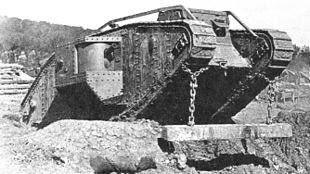
The Battle of Cambrai was a British attack in the First World War, followed by the biggest German counter-attack against the British Expeditionary Force (BEF) since 1914. The town of Cambrai, in the département of Nord, in France, was an important supply centre for the German Siegfriedstellung and capture of the town and the nearby Bourlon Ridge would threaten the rear of the German line to the north. Major General Henry Tudor, Commander, Royal Artillery (CRA), of the 9th (Scottish) Division, advocated the use of new artillery-infantry tactics on his sector of the front. During preparations, J. F. C. Fuller, a staff officer with the Tank Corps, looked for places to use tanks for raids. General Julian Byng, commander of the Third Army, decided to combine both plans. The French and British armies had used tanks en masse earlier in 1917, although to considerably less effect.

The Infantry Tank Mark II, better known as the Matilda, is a British infantry tank of the Second World War.

The Tank, Infantry, Mk IV (A22) Churchill was a British infantry tank used in the Second World War, best known for its heavy armour, large longitudinal chassis with all-around tracks with multiple bogies, its ability to climb steep slopes, and its use as the basis of many specialist vehicles. It was one of the heaviest Allied tanks of the war.

The Sturmpanzerwagen A7V was a heavy tank introduced by Germany in 1918 during World War I. One hundred chassis were ordered in early 1917, ten to be finished as fighting vehicles with armoured bodies, and the remainder as Überlandwagen cargo carriers. The number to be armoured was later increased to 20. They were used in action from March to October 1918, and were the only tanks produced by Germany in World War I to be used in combat, as well as being the first operational German Tank. It was developed as a response to British tanks. Although the A7V is generally considered to be better designed compared to its counterparts, it struggled to procure high production numbers due to its relative complexity and high cost.
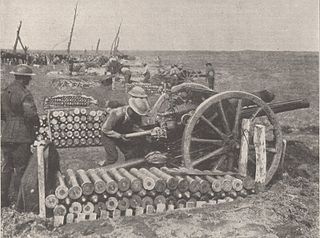
The Ordnance QF 18-pounder, or simply 18-pounder gun, was the standard British Empire field gun of the First World War-era. It formed the backbone of the Royal Field Artillery during the war, and was produced in large numbers. It was used by British Forces in all the main theatres, and by British troops in Russia in 1919. Its calibre (84 mm) and shell weight were greater than those of the equivalent field guns in French (75 mm) and German (77 mm) service. It was generally horse drawn until mechanisation in the 1930s.

British heavy tanks were a series of related armoured fighting vehicles developed by the UK during the First World War. The Mark I was the world's first tank, a tracked, armed, and armoured vehicle, to enter combat. The name "tank" was initially a code name to maintain secrecy and disguise its true purpose. The tank was developed in 1915 to break the stalemate of trench warfare. It could survive the machine gun and small-arms fire in "no man's land", travel over difficult terrain, crush barbed wire, and cross trenches to assault fortified enemy positions with powerful armament. Tanks also carried supplies and troops.
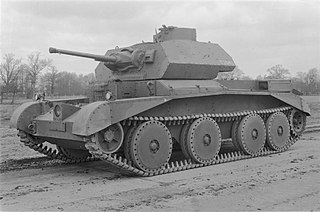
The Cruiser Tank Mk IV was a British cruiser tank of the Second World War. It followed directly on from the Tank, Cruiser, Mk III. The first Mk IVs were Mk IIIs with extra armour fitted to the turret. Later Mk IVAs were built with the complete extra armour. The tank was used in France in 1940 and in the early part of the war in North Africa, before being withdrawn from service. A fast vehicle compared to other British tanks of the early part of the war, it was probably the best tank Britain had in 1940. In total, 955 of these tanks were built.

The Ordnance QF 2-pounder, or simply "2 pounder gun", was a 40 mm (1.575 in) British anti-tank gun and vehicle-mounted gun employed in the Second World War.

The Tank, Cruiser, Ram was a cruiser tank designed and built by Canada in the Second World War, based on the U.S. M3 Medium tank chassis. Due to standardization on the American Sherman tank for frontline units, it was used exclusively for training purposes and was never used in combat as a gun tank. The chassis was used for several other combat roles however, such as a flamethrower tank, observation post and armoured personnel carrier.

The Gun Carrier Mark I was a British vehicle of the First World War. The gun carrier was designed to transport a 6-inch howitzer or a 60-pounder gun forward soon after an attack to support infantry in advanced positions. Gun carriers were first used in the Battle of Pilckem Ridge during the Third Battle of Ypres. The carriers moved guns and equipment but were used for the rest of the war mainly for carrying equipment and supplies through areas under fire, where porters in the open would have suffered many casualties. The 6-inch howitzer could be fired while mounted, making the Gun Carrier Mark I the first modern self-propelled gun, a weapon capable of independent action and having tactical mobility on the battlefield.
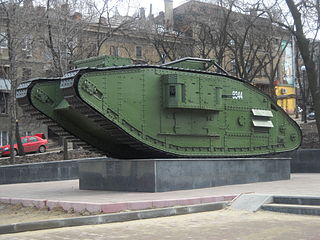
The "Female" tank was a variation of the British heavy tank deployed during the First World War. It carried multiple machine guns instead of the mix of machine guns and cannons mounted on the "male" tank. Lieutenant-Colonel Ernest Swinton, who played a part in the development of the first British tank and who was co-creator of the term "tank", is credited with inventing these gender-related terms, thinking that the best tank tactics would have the two types operating in concert.

The development of tanks in World War I was a response to the stalemate that developed on the Western Front. Although vehicles that incorporated the basic principles of the tank had been projected in the decade or so before the War, it was the alarmingly heavy casualties of the start of its trench warfare that stimulated development. Research took place in both Great Britain and France, with Germany only belatedly following the Allies' lead.

The British Mark V tank was an upgraded version of the Mark IV tank.

The Ordnance QF Hotchkiss 6 pounder gun Mk I and Mk II or QF 6 pounder 8 cwt were a family of long-lived light 57 mm naval guns introduced in 1885 to defend against new, small and fast vessels such as torpedo boats and later submarines. There were many variants produced, often under license which ranged in length from 40 to 58 calibers, but 40 caliber was the most common version.

The Ordnance QF 6-pounder 6 cwt Hotchkiss Mk I and Mk II was a shortened version of the original QF 6 pounder Hotchkiss naval gun, and was developed specifically for use in the sponsons of the later marks of British tanks in World War I, from Mark IV onwards.

The QF 6 pounder Nordenfelt was a light 57 mm naval gun and coast defence gun of the late 19th century used by many countries.

The British Army used a variety of standardized battle uniforms and weapons during World War I. According to the British official historian Brigadier James E. Edmonds writing in 1925, "The British Army of 1914 was the best trained best equipped and best organized British Army ever sent to war". The value of drab clothing was quickly recognised by the British Army, who introduced Khaki drill for Indian and colonial warfare from the mid-19th century on. As part of a series of reforms following the Second Boer War, a darker khaki serge was adopted in 1902, for service dress in Britain itself. The British military authorities showed more foresight than their French counterparts, who retained highly visible blue coats and red trousers for active service until the final units received a new uniform over a year into World War I. The soldier was issued with the 1908 Pattern Webbing for carrying personal equipment, and he was armed with the Short Magazine Lee–Enfield rifle.

This article on military tanks deals with the history and development of tanks of the British Army from their first use in the First World War, the interwar period, during the Second World War, the Cold War and modern era.
The Norfolk Tank Museum is a collection of armoured fighting vehicles in Norfolk, East England. It is located just outside the village of Forncett St. Peter and 10 miles (16 km) south of the City of Norwich. The collection is made up of mostly British vehicles from the Cold War. The Museum contains around 30 military vehicles as well as a large collection of small arms. It includes the prototype Centurion AVRE 165, the only remaining Crossley-Kégresse 20-30 cwt half-track and a replica British First World War Mark IV that was built for The TV show Guy Martin's WWI Tank.
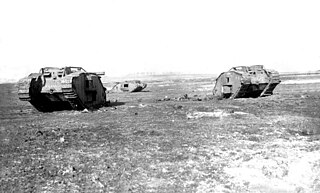
The lone gunner of Flesquières is a possibly mythical German officer who is credited with destroying up to 16 British tanks at Flesquières, France, during the first day of the Battle of Cambrai on 20 November 1917. British tanks were generally successful in their attacks on 20 November, except at Flesquières, where many were disabled by German artillery. British Commander-in Chief Field Marshal Sir Douglas Haig visited the battlefield two days later and was given an account by a British officer that stated that many of the tanks were destroyed by a single German artillery officer who had remained with his gun when his men fled and was killed at his post. Haig included the account in his March 1918 dispatch on the battle. It provided a convenient excuse for the failure to progress at Flesquières and a reminder to his men of the importance of close cooperation between infantry and the tanks.
